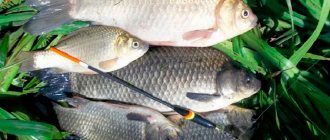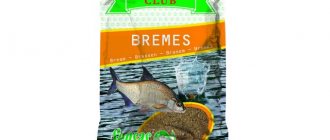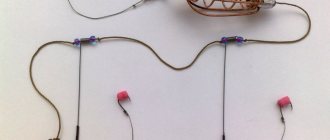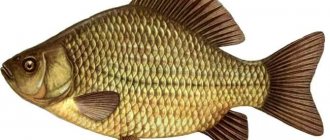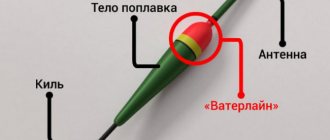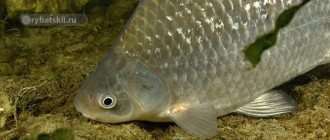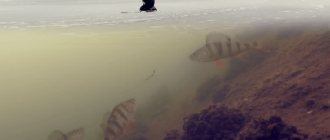Description and behavior characteristics
This fish has a round body with high sides, a golden or silver color, familiar to every angler. At the moment, there are two common types: gold, which has a predominantly rounded body shape, and silver, which is more oblong.
There is a misconception that crucian carp fishing is one of the simplest types of fishing, however, this is not so. You will ask why? The answer is simple: crucian carp is found in different types of reservoirs, and accordingly, its behavior and fishing patterns change in different conditions.
In ponds where crucian carp dominates, there is one drawback; as a rule, palm-sized specimens are already a success. If there is a predator in the reservoir, being careful, crucian carp can reach trophy sizes. What doesn't crucian carp like? So, these are cold rivers with fast currents, however, he easily copes with this situation by finding backwaters in the waters.
Golden crucian carp
And now more about the types of crucian carp:
- Golden crucian carp. A schooling fish in which specimens of various sizes coexist. Golden crucian carp often lives in wetlands, in places where there are a lot of lilies or algae. It is difficult to find this fish in places where there is a current. Under good conditions, such a fish can reach three kilograms with a length of 50 centimeters. In winter, crucian carp becomes less active and hibernates.
- Goldfish. A schooling fish, however, only females live in a school. During the spawning period, the eggs are fertilized by male goldfish. This species lives in low-flowing waters, or rather in large lakes or reservoirs.
Habitats of crucian carp
Silver crucian carp
- Small ponds. Small reservoirs with a small food supply, where it is often impossible to find other fish besides crucian carp. An example of such a place, lakes, are filled with meltwater in the spring. You shouldn’t expect to catch a trophy in such a place; a palm-sized fish is the standard size for such ponds. Nevertheless, crucian carp will peck at any bait.
- Reservoirs. Lakes in which crucian carp also live with carp, tench, pike perch and perch. Most often these are stocked spots or backwaters with a good food supply. After all, in such places natural selection occurs and the strongest fish survive; here you can hope to catch a good specimen.
- Rivers. Low flow rivers or reservoir backwaters. On rivers, crucian carp lives in quieter places, but during the spawning period it moves up the river. Most often you can catch bigger fish here.
In the end, a lot depends on the place of fishing. For a small pond, a small fly rod is enough, but on large lakes you have nothing to do without bottom tackle or long casting.
There is a huge amount of gear for catching crucian carp, let’s look at them one by one.
How, where, when and what to catch crucian carp
Crucian carp are caught from the shore, with a fishing rod, using all kinds of gear and natural bait.
Read my reports on fishing in Israel - here
5.1. Biting calendar - what time of year is the best time for crucian carp to bite?
Successful months for fishing for crucian carp are June and July.
The best time for fishing is 6 – 9 am, in the evening - before and after sunset. On hot summer days - at 12 - 14 o'clock in the upper water column.
5.2. What weather is the best time to bite?
Crucian carp bite in calm weather or when the wind speed does not exceed 10 m/s. In the cool months, there is active biting in sunny weather and vice versa, in the summer, when it is fresh, the presence of clouds, before rain. During heavy rain, adult crucian carp may eat.
A factor influencing the mood of crucian carp is the jump in atmospheric pressure that occurs during a change in air temperature. In case of sudden cold or warming, you need to wait 2-3 days for the pressure to stabilize.
To know in advance about the zhor on the upcoming fishing, get an aquarium crucian carp at home. Before leaving for fishing, throw some bread and the reaction of the domestic crucian carp will correctly tell you about the nature of today's bite.
5.3. What are the best places to fish?
Crucian carp are found in secluded places that serve as shelter and food for them - these are holes, reeds, mud, algae, and water lilies.
An ideal place for crucian carp
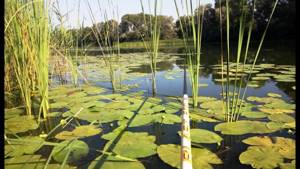
5.4. What gear is best for catching crucian carp?
There is a huge amount of gear for catching crucian carp; below we will describe those equipment that have been tested by time and to this day remain effective and in demand among experienced fishermen.
Fishing for crucian carp on a float in the Russian pond, where the fisherman shows and talks in detail about groundbait, lures and the nature of crucian carp bites
Catching crucian carp with a float In summer, crucian carp is caught with a float, most often with a fly rod, 4-7 m long and, as a rule, without a reel.
The primary focus is on the float. It should be:
- sensitive;
- not bulky;
- with low dough 1-5 gr.
Read a detailed article about the float, its components, their purpose and characteristics, get acquainted with the description of the whole variety of shapes of fishing floats and their purpose - here
An exception may be when you need to make a long cast in a deep reservoir, but this is a completely different fishing, since bites are possible, not only for crucian carp.
A buoy is attached to a 0.20 mm fishing line with a carabiner and secured with stoppers on both sides. Below, along the main line, pellets of different weights are distributed, from the float in descending order. The rig is completed with a leash with hook No. 5 (hook width 5 mm), tied on a mini swivel. The load of any float is individual, depending on weather conditions and distance from the fisherman. It is more correct to load the buoy so that the antenna of the buoy looks above the water 4 cm, during wind and waves 6 cm.
Photo of float tackle
Read all about how to correctly and securely tie a fishing swivel to various types of fishing lines, elastic bands, etc., in which case it is best to use one or another knot and know how to do it - read here
In spring, autumn, in clear water or when crucian carp are especially cautious, it is best to use 0.16 mm invisible line and 0.12 mm fluorocarbon leaders. Sliding sinker, sliding distance 7 cm and additional pellet near the undergrowth. The float is selected with 1-3 grams of dough, made of balsa, goose feather or linden material.
You can make a quill pen yourself, and it will be many times better than a factory one. Carefully cut off the fibers from the feather with scissors, cover with white varnish and, after drying, re-paint with firefly varnish, and for brightness, paint on the stripes with red acrylic paint. Now the float will be clearly visible during the day and at dusk.
Photo of dyed goose feathers
To make a quill feather sliding, you can apply a connector (size L) to it, after carefully sharpening the lower part of the feather. You can also attach an eyelet made of a steel needle at the bottom of the feather.
The float connector is a special device for floats that do not have attachment points in the keel area. The base into which it is mounted is rubber, the swivel with an insert is copper or steel. Available in sizes L, M, S.
Connector photo
Photo of a homemade eye made from a steel needle
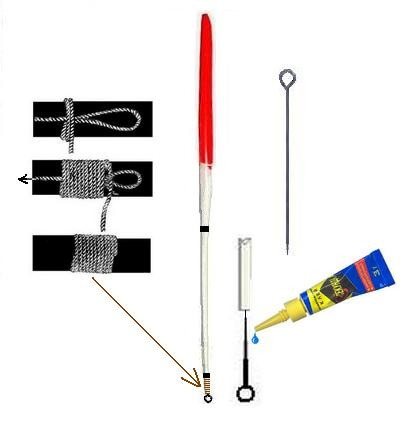
Here you can find a selection of the best deals on fishing products we found on the aliexpress website. Thanks to this catalog, you can reduce the cost of installing gear by 2, and sometimes 5 or more times. You will find a detailed description of various products, their characteristics and justification for the benefits of purchasing them. And if you spend 10 minutes and learn how to use cashback, you can additionally save up to 15% on all purchases in a Chinese hypermarket.
When all the accessories are ready, it’s time to assemble the ultra-sensitive float tackle for crucian carp. First of all, the float-feather is attached; if it is a “blind” installation, then on a cambric, if sliding, then on a mini swivel with a carabiner. The sliding float is fixed from below and from above by limiters. Then a sliding sinker “olive” is passed through, which is also blocked by stoppers on both sides. The last thing in the rig is the undergrowth with hook No. 4, and in front of the leash, an additional pellet is pressed - the undergrowth.
Now, at the slightest touch to the hook, the additional pellet will cause vibrations, which will instantly appear on the bite alarm. In the event that a crucian carp pulls the bait with a hook and even if it immediately lets go, it will hook itself: the sub, due to the inertia of the sliding load, will return back and hook the lip of the crucian carp.
Who doesn't know yet? You can return up to 15% of the price of your purchase on aliexpress. In addition to Aliexpress, the possibility of cashback (returning part of the money) also works for many other online stores. Here is a detailed description of this service and everything about how to work with it. It really works and helps you save a lot of money. The cashbacker website often runs promotions that allow you to buy goods at a discount of up to 90%.
Catching crucian carp with a jig The rod most suitable for fishing with a jig is the Bolognese type, without rings, 6-7 m long and with a fast action. There is no need for a reel; the equipment is wound onto the reel.
Many fishermen mistakenly fish with winter jigs, which do not “work” in summer, but only scare away fish with their bright colors. Summer jigs should be gray, dark green or black. Shapes: drop, ant, pellet, banana, uralka, bug, devil, witch.
Photos of jigs
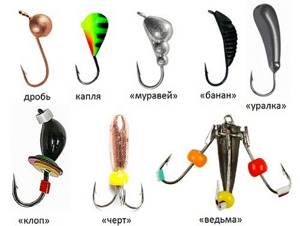
The fishing line is chosen no thicker than 0.18 mm; if the cord is braided, 0.10 mm is suitable. The weight and diameter of the jig depends on the depth of the reservoir and the size of the expected catch. At a depth of 0.5-1 m, use a jig weight of up to 1 g. In places where the depth is 1-2 m, they fish with a jig, up to 5 g. On average, jigs No. 5-7, 3.5 g are used.
If in winter fishing they try to use heavier jigs, with a quick immersion in the water, then in summer fishing, the opposite is true - crucian carp bite more effectively on a slowly and smoothly descending jig. In summer, it is best to make vertical retrieves, in spring and autumn, frequent bites of crucian carp on horizontal game.
The 7-minute video shows a close-up of knot options and how to properly tie a summer jig for crucian carp.
In calm weather, in clear water and on a light jig, a sensitive lavsan guard is used as a bite alarm, and on a heavier jig, they place a harder guard.
Photo of lavsan lodge
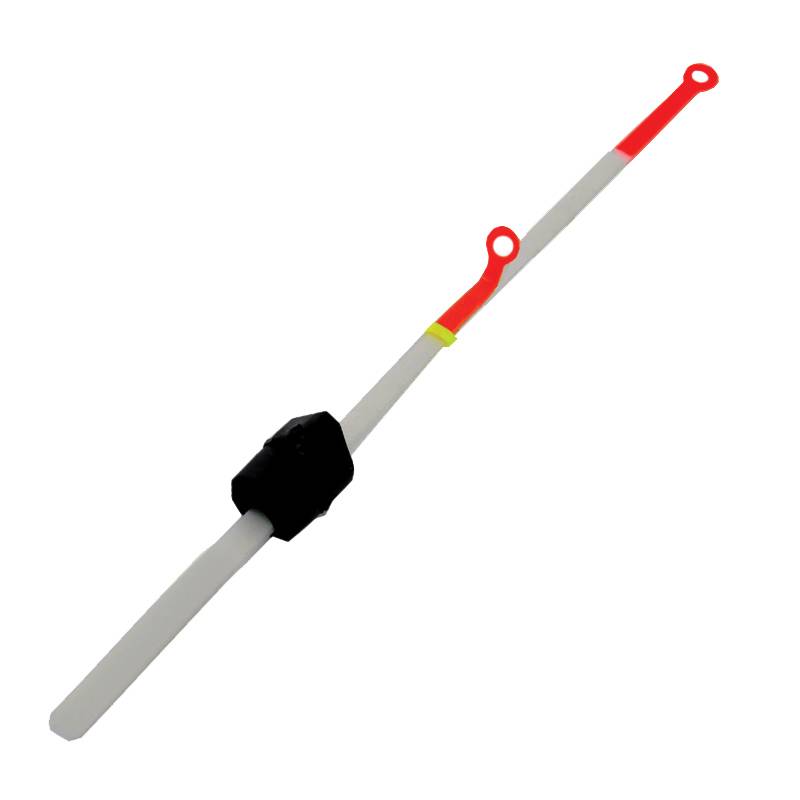
A guardhouse is a mini nod, which was originally used for ice fishing, but with the advent of the summer type of jig fishing, guardhouses began to be made for summer fishing.
Fishing for crucian carp with a feeder For fishing with weighty gear, such as a feeder, donka, top rod and springs, you also need a “stick” of the appropriate structure. It is advisable to use a plug rod, medium class, 3.9-4.20 m long, 3-3.5 lb test. Inertia-free reel, spool size 3000-5000, three or more bearings.
Large crucian carp are mainly caught on the feeder, in deep reservoirs and from the bottom. The tackle is assembled from 0.50 mm wicker material, green, black or leadcore.
Leadcore is a soft lead rod in a braided braid. Sold by the meter or in finished loops 50-70 cm long. It is used in many installations, does not get tangled when casting and fits on any bottom topography as needed.
Read the article about braided fishing line and you will learn about what it is, get acquainted with its characteristics and advantages, learn the features of its use in fishing, care rules and learn how to knit the most popular and reliable knots - here
Find out about the secrets of choosing braid in this article
There are many types of feeder feeders, for example
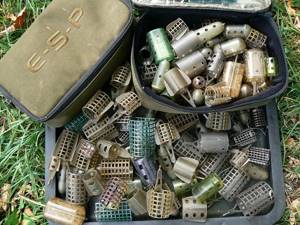
Consider a popular and catchy installation, with a rectangular black feeder
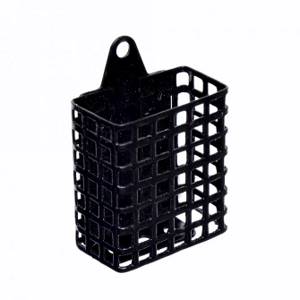
Installation consists of:
- feeder feeder 30-60 g;
- insert braid length 50-60 cm 0.30-0.40 mm section;
- immediately knit a swivel with 10 kg dough, to which the leash will be tied;
- It is advisable to cover the knot on the swivel with heat-shrinkable tubing, then string a stopper and an additional rubber bead, which will muffle the sound from the impact of the feeder when casting.
- after the bead, a tube with a carabiner is inserted against twisting to secure the feeder;
- on the reverse side, the feeder tube is also fixed with a stopper, and a swivel is knitted with 30 kg of dough, which will be connected to the main fishing line or cord;
- the leash for the feeder should be 20-25 cm long, 0.16-0.18 mm in diameter, made of wicker material, impregnated with carbon fiber. Such undergrowth will not get tangled and will withstand the temperament of any crucian carp;
- a hook No. 8-10 is crocheted in such a configuration where the head of the hook is concave towards the sting.
Don't miss a single detail when preparing a catchy installation? Then this article is for you. Read about fishing stops, their types, shapes, methods of attachment to various fishing elements - here
Photo of the ideal hook for feeder tackle
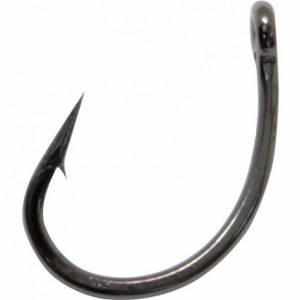
Feeder installation photo
The most detailed article about fishing hooks is here
Catching crucian carp with an elastic band This method of fishing differs from other rigs and at first glance may not seem convenient for fishing. In terms of catch quantity, it significantly exceeds other gear. It is important to tie the tackle correctly with an elastic band and adhere to the necessary details described in this section, and perhaps then this tackle will be your constant fishing companion.
Photo of tied tackle - rubber band
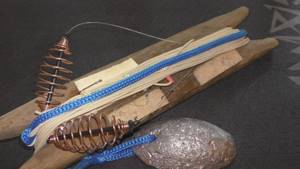
The length of the tackle is determined depending on the width of the reservoir; if fishing takes place on a narrow river, the elastic will be shorter and there will be no more than three hooks; if there is a large fishing area, then the elastic will be knitted for more than 100 m.
Let's look at the gear option that is most often used by fishermen, with a total length of 70 meters. Before assembling the installation, you need to prepare the components:
- 10 m of high-quality rubber, round, diameter 3-4 mm, 1×4 (1 m of rubber stretches by 4 m);
- main line (length 20 m) 0.30 mm;
- for stake (length 10 m) 0.25 mm;
- for undergrowth 0.16 mm;
- rope (length 2 m) 4-5 mm; hooks No. 5 with a long shank (7 pcs);
- sinker, flat shape, 250 gr.
To the betting line, leashes 20 cm long are tied, in the amount of 7 pieces, in the interval of 45-50 cm. In this case, they will not touch each other. The distance of the first undergrowth from the edge of the stake is 50 cm. To prevent the hooks from getting tangled during casting, cambrics are threaded onto the fishing line into which they are inserted. Swivels are tied on both sides of the bet.
The hook for the elastic band is selected with a straight shank and an even tip, 3 cm long
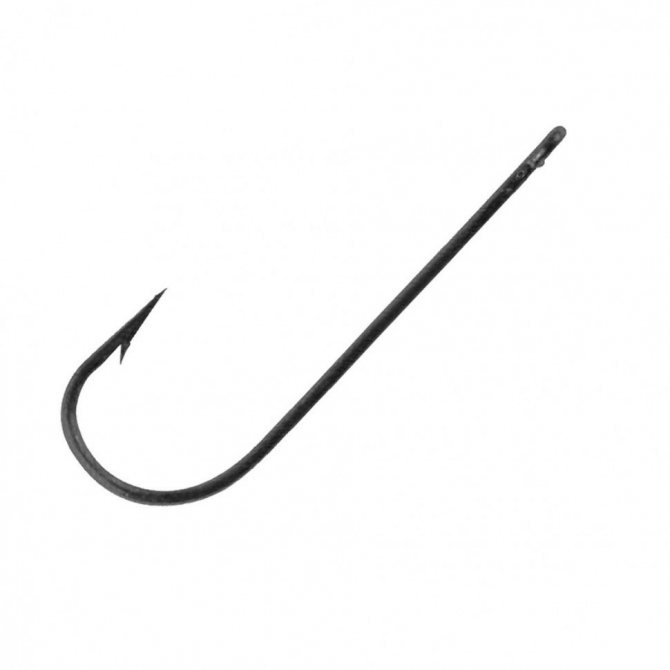
The wall of the stake, where there are no leashes, is connected to the main fishing line, and the other edge is connected to rubber. The sinker is tied to the elastic with a rope https://fb.ru/misc/i/gallery/65070/2463324.jpg
Installation of gum is brought in by boat or thrown from the shore. They cast mainly with their hands or with a spinning rod, so the tackle is fixed on the shore with a reel stuck into the ground or the spinning rod is installed in a vertical position. As a bite alarm, hang a bell on a stretched fishing line.
Place the bait after casting, pulling the main line up to the level of the undergrowth. After which, gradually and carefully release the fishing line, returning it to its previous position.
How to pull out a tackle with a sinker:
- standard option: the tackle itself, but sooner or later the rubber will break and the sinker will remain in the river.
- attach an additional safety cord to the load, and use it to pull it out.
- in the case of the delivery of elastic, a buoy is tied to the sinker, which remains on the surface after the tackle is immersed. At the end of fishing, the equipment is removed from the water by the float.
Adviсe:
- attach leashes, preferably between two beads tied in advance to the stake;
- 30 cm from the first undergrowth, make a loop. Before attaching the bait, this loop is hooked onto the protrusion of the reel so that both hands are free;
- For maximum catch, it is recommended, in the area of the first and last undergrowth, to thread one “dummy” spring onto the bet. The feeders are filled with bait while baiting the hooks.
Fishing for crucian carp on a makushatnik Tackle that came to us from the past. True, she has undergone external changes, but the essence of her work with crucian carp remains the same. There are countless assembly options and no one can say which is better.
We will install the initial installation, tested by fishermen over the years:
- The sinker must be at least 40 grams, lead, rectangular in shape, called a “hoof”.
- The main line is fixed to the threshold of the load; there is a hole in it. You can also pass the fishing line lower in and tie the loop with a slip knot, then with it, the top briquette will be fixed.
- The load and cake are additionally clamped with an elastic band cut into rings from a bicycle inner tube, 5 mm wide. During the disintegration of the briquette under water, the rubber will press the cake to the load more reliably than any clip.
- An important element of the tackle is the hook, it should be wide, the tip and fore-end should be even
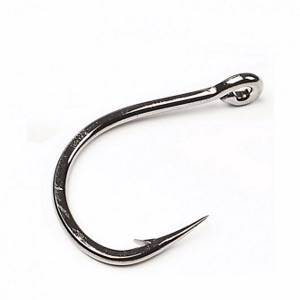
- The leashes are knitted from a braided cord 0.20-0.25 mm, 10 cm long, 2-4 pieces. They are threaded through the holes along the edges of the “hoof”.
Catching crucian carp with a pacifier. Any feeder is often mistakenly called a pacifier, and it does not matter whether it is a “flag”, “watermelon” or “dummy”. Initially, a pacifier was a triangular-shaped spring stuffed with mason jar. Fish, in order to enjoy the aromatic food, sucking, often by accident, fell on sharp hooks. This is how the saying appeared: give the crucian carp a pacifier
The principle of knitting feeders is the same for almost all, where three leashes with a hook of different lengths are used. The long leader on the swivel is at the bottom of the installation, the middle one is on top on the outlet, the short one is on the spring.
The nipple differs not only in the fishing method, but also in the assembly method; all leashes with 5-10 hooks are attached to the spring from the inside, and protrude outward by 5-7 cm.
A round sinker of 20-50 grams is passed onto the main leash, which is a braided cord 50 cm long. On the spring side, a mini swivel is tied to the cord, and on the main line side, a swivel with a larger carabiner is attached. The leaders are knitted from hard woven material 0.18 mm, the hooks are self-cutting - the point is slightly concave to the fore-end No. 5-7.
Suitable Hook Configuration
Tackle “Crucian Killer” This tackle appeared quite recently and has already gained popularity in the world of fishing. In fishing stores you can find factory-made “crucian carp killer” equipment, assembled in different ways: using steel bends, braided cord, snakeskin and even leadcore are used as the main material.
In fact, it is better to knit a “crucian carp killer” from shoe nylon thread, brown in color. The property of nylon is most suitable for tying gear with three springs. The assembled equipment will be approximately 35 cm long, but before assembly, you need to unwind the extra 20 cm so as not to “huddle” during installation. Centimeters also take beads and knots for swivels with a carabiner.
The most detailed article about carp hooks, their shapes, parts and sizes is here
For the gear you will need:
- 3 springs 3.5 x 1.5 cm;
- 6 beads (color: transparent, green, red);
- 2 swivels with carabiners;
- braid 0.16 mm 1 m;
- 3 forged self-cutting hooks No. 5-7;
- drop sinker on a swivel or ring 20-35 g.
How to weave beads: the edge of the thread is threaded into the hole of the bead, stretched about 15 cm, this is to leave 10 cm for the beginning of the tackle. Then again this edge is passed into the bead and not fully tightened so that the thread does not fit tightly to the beads, but the loop stands out. Now the edge of the thread is passed into this loop and again, do not tighten it completely, so that from this curl you leave a loop, and tighten the previous one and do this 4 times.
Many fishermen knit beads with three loops and then they have springs that move all over the gear. Because of this, fish often fall off and after each landing, the feeders need to be constantly adjusted.
After the bead is tied, a spring is inserted and the beads are knitted again, almost tightly. Leave a stroke for the feeder between the beads of 1-2 cm, and the distance between the feeders is 5 cm. When 3 springs are already mounted, swivels with carabiners are tied along the edges. Carabiner for weight, placed with 10 kg test, for swivel, on the main line side 20 kg.
Leashes with hooks are knitted 4 cm long with loops. They are attached to the springs by threading the hook through these loops. The leashes should be on the spring - closer to the load. Even if the crucian carp does not bite, it is nearby, pulling out the tackle, and the hook will “take” it with it.
Photo of the crucian carp killer tackle
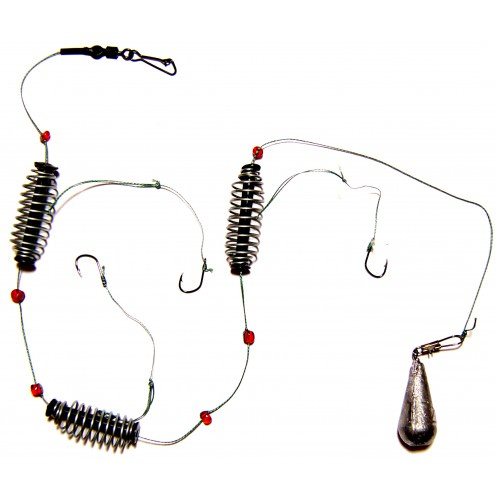
If you learn to combine the listed gear, then the fish tank will never be empty, even when there is no bite.
5.5. Baits for catching crucian carp
A universal bait that is suitable for luring crucian carp and for clogging feeders. Necessary ingredients: pearl barley, millet, barley, corn, vanillin and flavored oil for salad.
Preparation:
- Place water and bring to a boil.
- Add dry pearl barley at a rate of 1x3 relative to water.
- Turn the heat down and cook until the water becomes cloudy and the pearl barley doubles in size.
- Add millet, equivalent to twice as much pearl barley, mix.
- Add a pack of vanillin and add 1 tbsp. a spoonful of flavored oil.
- Stir again and continue cooking over low heat.
- Cook until the porridge absorbs a significant part of the water and gurgling bubbles appear in it.
- Then put out the fire and leave the porridge under the closed lid to absorb water and increase the grains.
- The porridge is ready.
- We move on to the second stage of preparing the bait: now pour the porridge into a clean enamel bowl and pour in the barley and corn grits, each in a ratio of 1x2 to pearl barley and mix thoroughly. The added cereals will absorb the remaining moisture and the porridge will turn out crumbly, and when squeezed, it will stick together.
If the viscosity is not enough, for example, the mesh in the feeder is too large and the bait falls out of it, then a little less barley and corn grits are added. By adjusting the proportions of the grains, you can get plasticine or, conversely, granular bait.
When buying ready-made bait in stores, you need to pay attention to the packaging, on the outside of which there is information about what type of fish the food is intended for. On the reverse side, the added ingredients are described. Often manufacturers do not indicate everything in the description, due to counterfeiting, competition and so as not to reveal their secrets. If you repeat what is written in ready-made store-bought bait, you are unlikely to get porridge of the desired consistency. The information is described in general terms only. If, for example, hemp is added, then the bait is oriented to increase the appetite of the fish, if caramel is for attraction, if flax is added, it is for quick digestion of the eaten food, so that the fish is always hungry.
To fish with a spring, you need to buy bait with the inscription on the package - feeder or with a spring pattern
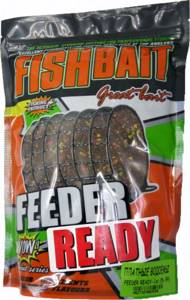
If the purchased bait does not have the required stickiness, then you will need to buy an additional stick (a binding component that gives the food viscosity). Proportions with food, 100 grams of stick per 1 kg of bait.
Photo of the stick
5.6. What baits and baits to fish with
Crucian carp is fickle in its taste needs, today it loves one thing and tomorrow another, but there are baits that it never changes. This section will be about them.
For maximum catch, the hooks of the float rig are baited with the following baits: maggots, worms (earthworms, dungworms, dendrobena (pieces), bloodworms, black bread, piglet balls, semolina.
Crucian carp loves semolina, and in order to use it as a bait, you need to learn how to make a sticky mass from semolina so that it does not fall off the hook. In this 9-minute video, watch how to properly prepare semolina dumplings.
They use a jig to catch crucian carp using peas. You need to buy ready-made peas in a glass container, and not in a can, because you can see not only the production date and expiration date, but also the bottom. In a quality product, the bottom will be free of precipitation.
The best attachment is when you bought peas yourself and cooked them. When making a purchase by weight, you need to ask the seller what year the harvest is, if this is the year, the peas are infused in water for 6 hours, if the previous year was 8-10, but a day is better. Cook over low heat for 30 minutes, last year’s for 1 hour. Properly cooked peas are almost overcooked and when pressed, they fly out of the skin like rubber. Such peas will not fall apart when placed on a hook and will stay on it for a long time.
You need to grab the peas, with the sting under the spine, so that the tip barely peeks out.
Photo of peas on a jig
In a feeder rig, they are effectively caught using a sandwich of peas, corn and pearl barley, placing them on the hook at the same time. To raise the hook with baits, sometimes it is necessary, for example, because of the overgrown bottom, use a large foam ball, dark green, yellow, burgundy.
Photo of a large foam ball

In the bottom tackle there is an elastic band, mainly baited with hooks - a worm, maggot or large bloodworm.
In the makushatnik, foam balls with the aromas of hemp, honey or tutti-frutti are planted and the tip of the hooks is driven along the edges of the makukha briquette. As the cake breaks down, the foam nozzles lift the hooks and the fragrant balls mix in the resulting food cloud.
Fishing on springs, “crucian killer” and “nipple”, a foam flavored ball with bait is placed on the hooks: a red worm, maggot and semolina. The best bait in terms of catch results is corn popcorn produced by the Hungarian company cukk with the addition of garlic or honey. When equipping springs in this combination, you need to take care of a spacious cage.
Photo of popcorn cukk garlic
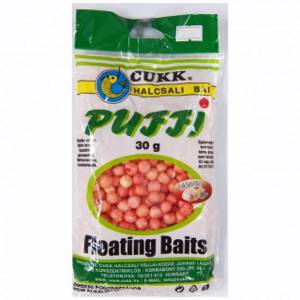
Photo of popcorn cukk honey
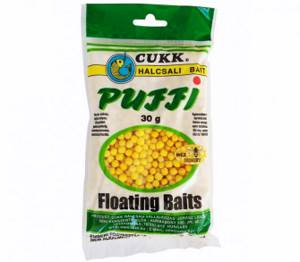
5.7. How does it bite?
The bites of crucian carp are not constant, they depend on how hungry it is and what size it is. 100-300 gr. A crucian carp can move the bait until it is accidentally caught, but then another fry will start moving the buoy again. Misses will allow you to adapt to what moment you need to hook. It happens that while the float is moving, you pull out the tackle, but there is no one on the hook, or vice versa, when there is no bite, you fish for crucian carp with a deep-swallowed hook.
An adult crucian carp, when hungry, pulls the bait quickly and confidently, and then stops - it tries the bait, but does not swallow it. The unpredictability of crucian carp forces the angler to always be careful. After the bite you need to wait for the outcome. It is necessary to fish when, after movement, the buoy goes under the water, lies horizontally or rises up.
5.8. How to fish correctly. — Basic techniques
They hook the crucian carp quickly and just as quickly pull it ashore, not allowing it to swim into the reeds or wrap itself in mud. With a heavy viscous mass, the crucian carp will be many times heavier, which can promise not only a break in the fishing line, but also a break in the rod.
5.9. The most important points when catching crucian carp
Crucian carp is constantly in the grass, mud, reeds, and you have to throw the tackle in those places where the fishing line gets tangled, algae sticks, which makes fishing much more difficult.
Before fishing, it is important to clear the intended places for casting. The mud is removed with a long thick stick, making a 2x2 m window in the green carpet. The reeds are cut with pruners to avoid hooking.
Float tackle
One of the most common methods of catching crucian carp. Despite the widespread use of competitive gear, fishing with a float is one of the most accessible and easy types. Let's take a closer look at what is needed for this:
- The rod should be from 4 to 7 meters, since the tackle will need to be placed in places where there are no algae or lilies.
- An inertial light reel, a spinning reel would be inappropriate.
- The diameter of the main line is 0.14-0.18 millimeters; for a leash, a diameter of 0.08-1 millimeters is suitable.
- Float no more than 4 grams.
- Hook No. 5-6.
In the summer, it often happens that fish move in schools, but do not approach the shore, then sliding tackle . The basis of the tackle is a sliding float on a swivel from 3 to 10 grams. Heavy floats are chosen specifically for long-distance casting.
Why doesn't the crucian carp bite?
Crucian carp will not bite in a pond only if it is not there.
In other cases, he bites, but you need to take into account all the factors influencing the fish’s bite. Why doesn’t crucian carp indulge fishermen with active biting:
- Incorrectly selected gear. Crucian carp is not large in size; its weight generally reaches 200 - 300 grams, and it is also very careful, so heavy tackle is not suitable for catching crucian carp. The tackle should be equipped with a light sinker, up to 5 grams, and a light float that responds well to the slightest touch of the bait. When fishing in a pond, the donka should not be equipped with a sinker. Enough feeder.
- Error in choosing the time of day. In some cases, crucian carp bite only in the morning and evening dawn, sometimes all day, and sometimes only at night. If there is an abundance of food for crucian carp in the pond, it bites only in the morning and evening dawn. Weak food supply - he feeds all day. There are predators in the pond; crucian carp feed only at night. Two fishermen went fishing for a day. We planned to cook fish soup in the evening and have a good dinner. But all their efforts to catch at least one crucian carp were unsuccessful. The disappointed fishermen drank tea in the evening and decided to go to bed, get up early in the morning and try their luck at dawn. After lying for a long time, one couldn’t stand it and decided to try night fishing. I put a glowing cambric on the float and cast the fishing rod. A few minutes later the float twitched, hooked and there was a good crucian carp on the shore. The second and third casts ended with the same success. He called his friend. During the night they caught up to 5 kilograms of crucian carp. As soon as dawn broke, the bite stopped. It turned out that there were pike and perch in the pond. At night, predators are not very active, so crucian carp lie down in the grass during the day and come out to feed at night. It is important to know the features of the pond and its inhabitants.
- Inappropriate season. This applies to shallow water bodies. In summer they warm up well and quickly become overgrown with grass and begin to bloom. All this takes oxygen from the water and makes it not very convenient for crucian carp to live. At this time of year, crucian carp rest at depth. It is active only in spring and autumn, when there is no flowering yet, or it disappears.
- Bad weather. Crucian carp does not like heat, high and medium pressure, or strong wind.
- Negative influence of the moon. The influence of the moon affects all areas of life on earth, including the behavior of fish. Crucian carp behaves actively on the waning moon, passively on the waxing one.
- The bait does not match the taste of crucian carp. It is better to get bait from the bottom of the reservoir where fishing takes place or near the reservoir.
- Presence of competitors. Crucian carp behaves very passively if it is alone in the pond. There is plenty of food for him. Its activity increases significantly when other species of fish live next to it, and the more of them, the more active the crucian carp is.
- Presence of predators. Fear for their lives forces crucian carp to eat intensely in order to grow faster. The presence of predators in the pond increases the activity of crucian carp.
Feeder tackle
During the spawning period or in the summer, in large areas of water, crucian carp are caught using a feeder. This is a tackle that lies on the bottom; a bite is registered by a nod of the sensitive tip. What do we need for this:
- The rod should be between 2.8 and 3.3 meters long for long casting.
- Here you can’t do without a 2000 spinning reel.
- The diameter of the fishing line is 0.18-0.2 millimeters.
- Feeder up to 45-50 grams.
- The bait must be selected under the pond.
- Hook No. 4-6.
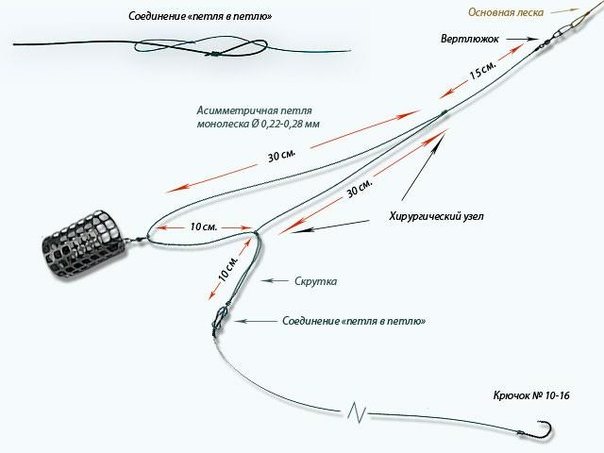
The main difference between a feeder and bottom gear is the sensitivity of this equipment. A bell is usually hung on the donk, which reacts to a bite; the feeder alarm bends when bitten. The nods on the feeder can be changed by selecting the desired system for a particular fishing.
Tackle “Crucian killer”
This equipment is widely used among amateur fishermen and is unsportsmanlike among professionals. The fact is that this tackle is heavy and there will be no sensitive bite due to the fact that the fish needs to pull the entire tackle, so when the fish feels resistance, it will simply hook itself.
Advantages of this equipment:
- When casting, the bait is delivered by three springs, therefore, the bait will take less time. However, do not forget that the bait must reach the bottom and then begin to wash out.
- An increase in the chance of a bite by 3 times is achieved by using more hooks and bait.
- Other carp species also respond well to the tackle.
Disadvantages of this equipment:
- Low sensitivity, which makes it difficult to determine a bite by the nod of the rod.
- More hooks mean more chances for them to get tangled with each other or with the feeders. This unpleasant moment can be circumvented by making the leashes on the hooks minimal.
- Irrationality. One hook with a feeder is enough, and the tackle is already sensitive.
In conclusion, we can say that this equipment is suitable for amateurs who will catch large fish, because when biting a small fish, the amateur will not see the moment of the bite.
For production we will need:
- Monofilament with a diameter of 0.3-0.4 millimeters.
- Weight with an eye.
- Carbine with swivel.
- Springs, inside of which there must be tubes.
- Hooks.
We mount the tackle:
- We attach the carabiner with a swivel to the load.
- We attach the swivel to the feeder with a fishing line of about ten centimeters, limiting the feeder on both sides with locking knots.
- Using the same method, we connect 2 more springs.
- At the end we make a leash with a loop using a figure eight knot.
- We tie leashes to the feeders.
Kinds
Selection processes have influenced not only the number of living individuals in the world, but also the varieties. Thus, today there are about 5 species of crucian carp in the world. They have different purposes: mainly for fishing, but there are also decorative variations.
Yellow
Yellow crucian carp is also known as golden carp. Compared to all other representatives of different species, this fish is the most hardy and unpretentious. Golden crucian carp can exist even in conditions in which the oxygen content in the water is very low and the reservoir is very swampy. Such fish can even survive during periods of short-term drying out of the reservoir, simply by burying themselves in the silt. The scales of representatives of this species are golden-copper in color; some parts of the body, especially the fins, can be bright red or burgundy. In Russia, this species lives in the European part and in Siberian waters. In particularly cold areas of the country you will not be able to find this fish. Like most representatives of its genus, yellow crucian carp is found near the bottom, where it finds food. This fish loves quiet, calm places, mostly dark, so you should look for it in pools, overgrown lakes and swamps. It does not sink to great depths; 2-2.5 meters is enough for it. The crucian carp eats what it finds in a thick layer of soft silt: live crustaceans, parts of plants, roots, larvae. Due to the fact that such food is abundant in all parts of the reservoir, crucian carp generally do not migrate anywhere from their habitable place.
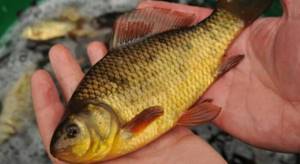
Chinese
An interesting fact is that every person at least once in his life has seen a Chinese crucian carp at least in a photo, without even knowing it. The solution to this mystery is simple: Chinese crucian carp is a goldfish widely known throughout the world.
Back in the 7th century AD, people domesticated the silver crucian carp, and through hybridization and unknown genetic changes they managed to develop this ornamental breed of fish. Nowadays, goldfish are the most common pet living in an aquarium. Today, there are many variations of Chinese crucian carp, nth “subspecies” that differ in color and appearance. So while goldfish may indeed be gold in color, they can also be black, copper, orange or white. There are other color options, such as spotted, pearlescent, red and white (which is typical for Asian fish breeds), etc. Regarding the appearance of different goldfish, it should be said that different masters from Europe and Asia did their best here. Therefore, today you can see all kinds of variations of Chinese crucian carp with bizarre bulging eyes, with lush fins similar to the plumage of birds of paradise or peacocks, an unusual round body shape similar to an egg, bony or warty growths on the head, forming some kind of “cap”.
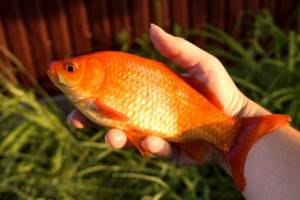
Common river
Common river or silver crucian carp lives in the wild, inhabits swampy reservoirs and feeds on what it finds in the muddy soil of rivers or lakes. It is worth noting that goldfish can live in river environments with moderately flowing water. In comparison with its other wild counterpart, the golden crucian, the silver crucian looks somewhat different: the body of this fish is tall, short, but more elongated. The scale plates are large, silvery-white or gray-green in color. Specimens of yellow and orange shades are very rare. Experienced fishermen usually associate the color of fish with the quality and quantity of food in the reservoir. Therefore, those who like to fish should take into account that the predominant percentage in the diet of silver crucian carp is made up of crustaceans.
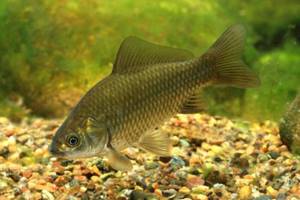
Black
Also known as Arabian seabream. Outwardly, it is completely different from its freshwater counterparts: the marine subspecies has an oval, smooth body shape, without humps, with flat sides and a large head. The lips are firm, slightly pushed forward. Horny jaws and blunted teeth allow sea crucian carp to crush and chew very hard food. The body color is light gray, turning in a gradient to black, from the belly to the back, respectively. The fins are dark. This fish lives in the tropical waters of the Indian and Pacific Oceans, as well as in the Black and Azov Seas. Representatives of this species live at great depths, about 50 meters, and readily inhabit areas with sandy and silty soil. Sea black carp are rarely seen alone; they prefer to gather in small groups. Despite the fact that this fish swims mainly in sea waters, sometimes it can be found at the mouth of rivers, or even in fresh water. The diet of black crucian carp is mostly represented by mollusks, crustaceans, sea worms and aquatic plants. This species is not very picky about food, which is successfully used by fishermen. However, this fish is very useful for people: it contains many vitamins and minerals, such as iodine, copper, manganese, zinc, polyunsaturated fatty acids, which ensure good functioning of the joints and brain, relieving local inflammation.
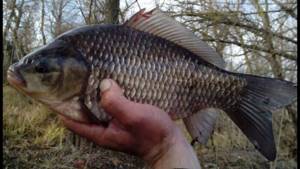
Mirror
The original habitat of the mirror crucian carp is Germany, from where this fish spread to the waters of Europe and Russia. A distinctive feature of this species is the sparse scales on the body, and even if they are present on the body, they can be easily noticed. The scales of the mirror crucian carp are represented by round, very large and durable plates, which give the name to the animal itself: if you look closely at them, you can really see the effect of reflecting the environment. Scientists believe that this is a kind of mimicry, camouflage for this herbivorous fish. Externally, the mirror crucian carp differs from its peers in its genus by its humpbacked and elongated body, which is crowned by a large elongated head.
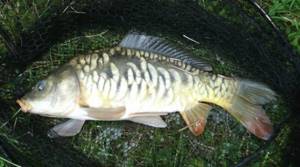
Amursky
The more common and generally accepted name for this fish is Far Eastern crucian carp. The name “Amur” was attached to this fish due to the fact that its homeland is the Amur River. At first glance, the “Far Eastern” looks similar to the silver crucian carp: they have a similar body color, silver or green-gray, but representatives of the Amur breed are usually darker. Also, Far Eastern crucian carp are one of the largest among all their fellows, body length can reach 70 cm, and weight – 8 kg.
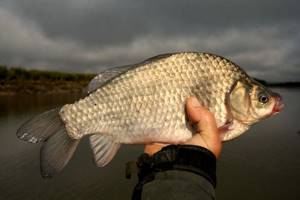
Japanese
This crucian carp is especially valued as one of the main images of traditional Japanese aesthetics. This fish decorates elaborate garden fountains, swims in ponds, in aquariums in the pavilions of shopping centers, and in the homes of noble families. They create a surprisingly rich coloring on the water surface. The classic body color of Japanese crucian carp is red and white, but it is difficult to count how many unusual variations of the color of crucian carp there are: there are gray, three-color, plain, black, etc. The body shape resembles a goldfish, only larger. This breed of fish is famous for its endurance and ability to adapt to the difficult environment of a changing climate and seasonal weather patterns.
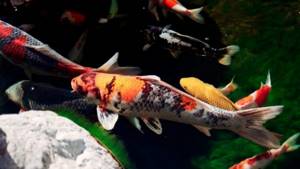
White
This fish is also known as Cuvier crucian carp. This breed was also bred in Japan and is more of a subspecies of goldfish than a direct cousin of the common crucian carp. From Japanese waters, white crucian carp spread to the island of Taiwan and the Korean Peninsula. Prefers bodies of water with moderate or slow currents and requires high water aeration. Most often, this fish lives in artificial ponds as an ornamental animal. Interesting fact: thanks to the spread of these fish in the Land of the Rising Sun, an amateur fishing method called “herabuna” appeared in Japan, which literally translates as “Japanese white crucian carp.” This method is familiar to Russian fishermen and consists of catching fish with a float rod. It is noteworthy that the Japanese traditionally catch only crucian carp or crucian carp using the “herabun” method, and only occasionally other peaceful fish. For this kind of fishing, a unique dust dough is used, which at the same time holds tightly on the hook and distributes special crumbly particles to the surface of the water. This allows you to create an appetizing bait for fish.
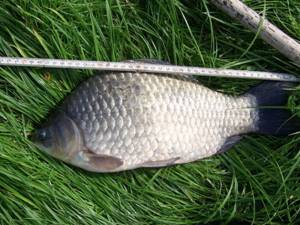
Internal structure
An important feature and distinctive feature of representatives of this subspecies of fish is the number of gill rakers, which are located on the gill arch. These stamens perform one function, but it is extremely important for the existence and functioning of the creature - air filtration. As mentioned above, crucian carp mainly live in swampy bodies of water, which can have a fairly low oxygen concentration. Accordingly, fish need a powerful biological apparatus to properly supply the body with vital gas.
An important place in the internal structure of these creatures is the lateral line of the body: with its help, the fish senses air vibrations and determines the location of insects, beetles and crustaceans, which it eats. The distance at which crucian carp is able to detect vibrations is about 50 cm. The taste organs of this fish are very developed, and sensitive receptors are located not only in the mouth, but also on the head. Therefore, the animal only needs to get closer to the potential food and understand whether it belongs to its diet or not.
Since the predominant percentage in the diet of crucian carp is vegetation, this fish has a long intestine that is 3 times larger than the body size of the fish itself. Special pharyngeal teeth, located on the gill arch and protruding in the pharynx, help absorb food and grind it. They are not dangerous to humans, but even in this case, you should handle the fish carefully to avoid injury.
Predator or not
Crucian carp is very difficult to define as a predator. As follows from the description of the diet of this family of fish, crucian carp feeds mainly on plant food and small crustaceans, with the exception of the Arabian sea species, which can sometimes profit from small fish. The rest of the diet of crucian carp belongs to the herbivorous type of nutrition. However, history knows of cases when fishermen found the remains of a relative in his stomach. The phenomenon of cannibalism in these animals is surprising, but it can be explained. According to ichthyologists, intraspecific cannibalism may be due to a sharp depletion of the food supply in a certain biotope. Due to the fact that the diet of crucian carp is very wide and includes many categories, cases of eating relatives of this species of fish are extremely rare. Another reason explaining cannibalism is competition for territory and the right to fertilize, which also happens extremely rarely.
However, returning to the question of whether this animal is a predator, it is worth recalling the words of the famous ichthyologist I.F. Pravdina: “...Fish are divided into peaceful and predatory. The former feed mainly on plant food and invertebrate animals, the latter eat fish, birds and mammals...” Based on data on the lifestyle of crucian carp and their feeding habits, we can safely say that it is not a predatory species.
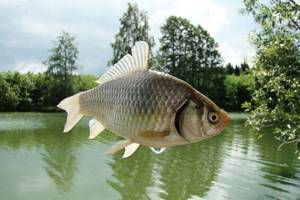
An interesting fact: young crucian carp are often used as live bait for catching predatory inhabitants of water spaces, especially pike.
Catching crucian carp on the makushatnik
There are 2 options for this fishing:
Bait on a hook
Makukha can be used with baits suitable for catching crucian carp.
Most often these are pellets and worms. The granules come in a variety of flavors. The most popular ones are with the smell of anise, hemp, and sweet ones with strawberry flavor. Many people are afraid that when the granules become soggy, the hooks will be exposed and this will scare away the fish. There is such a possibility, but it will have a greater impact on a small animal than on a large one. They also use a regular dung worm. It is worth choosing several pieces and large ones, because this will help in cutting off small fish. Large fish will suck on it for a long time, eventually eating it.
Other attachments will be ineffective and impractical to use.
Carp
In this case, we drill shallow holes for hooks in the crown. For this option, you should take flavored makukha, with the smell of vanilla, hemp or strawberry.
Nipple fishing
Let's consider another sensational fishing method that is not inferior to the feeder.
For production we will need:
- The rod is about 1.9-2.9 meters, with a test weight of no more than 45 grams.
- Spinning reel 3000.
- Cord, 60-70 meters long with a diameter of 0.3 millimeters.
- Braided leashes 15-20 centimeters.
- Hooks No. 6-10.
- A nipple made in the form of a spring.
- An ordinary bell.
Lure
You can fill the nipple with any porridge, but it is better to use mastyrka with a little dill and garlic added to it.
The bait for fishing is quite difficult to guess, so you need to stock up on as many varieties of bait as possible. The most necessary: worm, maggot, bloodworm, pearl barley, dough, corn, polystyrene foam.
Having loaded the pacifier with everything necessary, we select the place of casting. The most optimal place would be a difference in depth, thickets, edges. Having abandoned the tackle, the food will begin to gather dust. Having discovered a delicacy, the fish will tighten the bait and thereby get caught on the hook.
Spring for catching crucian carp
Another popular piece of gear is popularly called a spring. Let's look at it in more detail. Let's start with the fact that it is a bottom tackle consisting of a feeder into which porridge is stuffed. The advantage of this rig is that the hooks are always located close to the feeding spot.
Springs can be divided into:
- Size : available in small and large.
- Shape : pear-shaped, cylindrical, conical.
- The presence of cargo or without it.
Types of gear with a spring:
- Self-cutting - in this equipment, the load goes along with the spring.
- Moving - which requires cutting.
Rubber band for catching crucian carp
This tackle is nothing more than thick rubber with a heavy sinker at the end. Usually the elastic band is about 10 meters long. It is attached to a fishing line on which 3-10 hooks with leashes are placed. The convenience of this gear is that it is cast at the beginning of fishing and reeled in at the end.
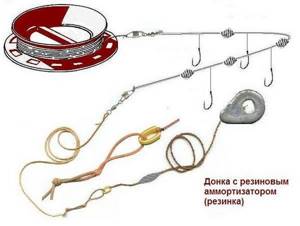
Hooks on the bottom are placed at a distance of 15-25 centimeters, which allows fishing at different depths. For a better bite, you can attach a small feeder to the fishing line. We can see the bite by looking at the guard or, if desired, you can hang a small bell. Inconvenience when fishing can be caused by tangling of hooks.
Pulling out the elastic can also spoil the mood, since the bottom is sometimes silted, and the load is simply difficult to pull out, and most often you have to tear off the load and, accordingly, shorten and damage the elastic. To avoid this, it is worth tying a separate strong fishing line to the load in the form of a safety line. And when you finish fishing, pull it not by the elastic band, but by the neutral line.
Fishing methods
Usually crucian carp are caught in the summer using bottom and float gear. At the same time, in some reservoirs it bites better on the bottom, and in others on the float. The method of fishing itself matters only to the angler; for crucian carp, the main biting factor is the bait, bait and fishing location.
For example, in heavily overgrown reservoirs, in windows of aquatic vegetation, where the bottom is densely covered with thickets of hornwort, it is not possible to fish with a bottom. On the contrary, where the bottom is relatively clean, level, without snags, and the crucian carp does not want to come close to the shore, fishing with bottom gear will be more convenient and will bring better results.
Self-catchers are often used. This is due to the fact that in an unfamiliar body of water it is difficult to reliably determine the time when fish enter a certain place. Therefore, they try to cover a fairly large coastline by installing self-propelled gear. Crucian carp has fairly constant habits. When the time and place of exit have been determined, it is much more effective to switch from self-catching to active gear in this area.
Flying float rod
Tackle No. 1 for crucian carp. Since this fish often prefers coastal areas, there is usually no need to cast long distances or use a reel. You can get by with a light and relatively inexpensive fly fishing rod, which consists of a rod with a fishing line rigidly attached to its tip, equipped with a float and a hook.
A fly rod can be used of various lengths, but for catching crucian carp it is better to use a rod of 4-6 meters. Longer ones will require constant use of stands, since it will be difficult to hold them in your hands all the time. However, when fishing for crucian carp, the use of rod stands is not a problem, since they are caught using a standing rig. In still water, 2-3 rods are most often used, cast at different distances from the shore, and different baits are used. This significantly increases the chances of a fish biting. It is the ability to fish from stands that makes a fly rod the best choice; even with a large, heavy rod, the angler will not get tired and you can use several tackles.
The main advantage of a fly fishing rod is that it allows you to cast the equipment very accurately, perform high-quality hooking, use thinner fishing line and, as a result, a lighter float with less load under the same fishing conditions. Fishing in windows, fishing with the lightest possible tackle, fishing with a very precise release of the fishing line, allowing you to clearly place the bait on the bottom vegetation carpet, allows you to achieve better results when fishing for crucian carp using a fly rod than when fishing with other gear.
Match fishing rod
Not a very popular tackle, and completely in vain! In terms of cost, such fishing is not much more expensive than feeder fishing. However, for crucian carp places, match fishing is preferable. It allows you to cast the tackle quite accurately, fish on a very snagged or overgrown bottom, and fish in cluttered urban and suburban ponds, where when fishing with bottom gear there will be a lot of snags and cliffs.
At the same time, a match fishing rod allows you to fish distant sectors from the shore. Using modern match pop-up floats and equipment, you can clearly see the bite at a great distance from the shore, and keep the float from being displaced by the wind with the help of a system of catches lying on the bottom.
You can successfully cast into large windows at a distance from the shore, and when you pull out fish, you collect much less grass than would be the case with bottom tackle.
Bolognese fishing rod
Not so often used for catching crucian carp. Such a tackle is fully revealed only in the current, where it is quite rarely caught. But sometimes, when catching silver crucian carp in the channels, it is the lapdog that becomes the best choice. Typically, a Bolognese fishing rod for crucian carp is used in still water, where they want to cast long distances from the shore. At the same time, it significantly loses in the convenience of fishing, and in the range, and in the accuracy of casting, to a match fishing rod. And when fishing from the shore without casting with a reel, the tackle will be much heavier and rougher than a fly rod with the same capabilities. However, if there is no other fishing rod, Bolognese tackle will do.
Donka
Bottom fishing for crucian carp works best in the late period, with the onset of cold weather. At this time, aquatic vegetation dies off, the donka will carry less grass. Usually in the summer, along with the fish, half a pound of water stems are also pulled out. Therefore, the tackle must be strong enough to withstand all this. A cheap fiberglass spinning rod is used as a fishing rod in a “Soviet” style donk, an inexpensive inertial reel is installed, a fairly thick main line is used, and, as a rule, they are caught without a feeder. The tackle is very simple, but it has many disadvantages that other bottom tackle - a feeder - lacks.
Much more often, instead of a donkey with a rod, a type of hook is used - fishing for crucian carp with an elastic band. An elastic band is a bottom in which there is an elastic band 3-10 meters long between the main line with hooks and sinkers. This makes it easier to re-throw the tackle during frequent bites and always return the hooks to the same place. Of course, the fishing distance will be shorter. But when fishing for crucian carp, long casting is rarely required.
Feeder and picker
They are a further development of the bottom fishing rod, more modern and convenient. The main features of these tackles are the use of a special flexible tip as a bite alarm. They allow you to cast more accurately and farther with a lighter load, which is essential when fishing among grass. Ultimately, a tackle with a light sinker will collect less of it. Both fishing line and cord are used, and fishing line for crucian carp will be preferable.
Fishing usually takes place at shallow depths, a short distance from the shore. Catching crucian carp with a picker, a type of feeder, allows you to get more pleasure from pulling out fish with thinner and lighter tackle. In addition, the picker itself will be much more convenient in such conditions, since the shore is often overgrown with bushes and trees.
Very often, when fishing for crucian carp, a flat feeder weight is used. The carp feeder of the “method” type sinks less into the silt and releases food on its surface better than the classic feeder “cage”. But at the same time, it is more demanding on the quality of bait and mixing. A banjo-type feeder allows you to catch aquatic plants even from a carpet, when the load is not immersed in its thickness. Quite often when catching crucian carp, the hooks remain in the bait to give fewer hooks. The same principle is implemented in the “nipple” fishing gear.
"Cork", "pacifier", "phantomas"
All these names refer to self-catching gear, when hooks with bait on leashes are immersed in a feeder weight filled with bait and completely open on one side. In this case, leashes are usually tied to the sinker itself. And it is attached to a fishing line and cast at a distance from the shore. Thus, the hooks are almost completely protected from snagging on algae.
Crucian carp, approaching the feeder and eating food, can in the process also pull in the hooks, getting caught by them. Therefore, they will not get caught even when the bait is eaten - after all, fish will sit on them.
The main disadvantage of such gear is that you need to use the smallest hooks, almost swallowed. This leads to the fact that the main prey will be small fish, since it will feel a large hook and spit it out, because the tackle is self-catching, and there is no timely hooking here.
Also, catch-and-release fishing, or catching crucian carp with live bait, becomes impossible. The fish swallows the small hook deeply, so you have to take it all out and then fry it. It is best to make the leashes removable so that you can remove the fish from the hook at home. It is much better later, in a calm environment, to see the fishing line sticking out of the fish’s mouth, and pull it out along with the hook when gutting. Why, while fishing, pull out a hook, tear it off, forget it in the fish and then eat it yourself. Such gear cannot be seriously considered in modern fishing, since in terms of catch, fun of fishing and quality of fish it will be inferior to all other gear.
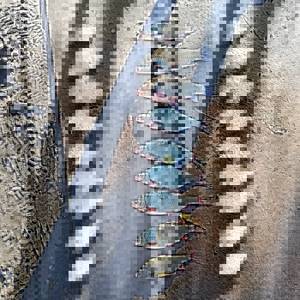
Summer jig
It is used very successfully for catching crucian carp. In the spring, when the water is cold enough, it allows you to attract fish by playing to the bait. In this case, it is best to use two jigs - one heavier, which often plays the role of just a load, and the second, lighter, is attached higher. This allows you to “slow down” the game by placing the lower jig on the bottom, since the crucian carp takes the standing bait better. Instead of the top jig, you can tie a simple hook with an attachment.
Another “specialization” of the summer jig is fishing in heavily overgrown places and windows. Here the line practically does not deviate from the vertical. Therefore, it is possible to fish even in the smallest windows, between the stems of reeds, avoiding snags. It is unlikely that you will be able to do this in other ways, except with a fly fishing rod, but there is still a higher risk of snagging or tangling the tackle.
Winter gear
Winter fishing for crucian carp is no different from fishing for roach, except that the tackle is more durable. Use a jig and a float rod. It is best to use rods that allow you to stop the game with bait and at that moment the fish bites. They are often caught with several fishing rods, using bait alternately or without playing at all.
The second group of winter gear is various self-catchers. Fishing for crucian carp on crosses and girders is popular, especially on an unfamiliar body of water, where they do not yet know the places of its most active biting. Worms are used as bait for self-catchers, sometimes vegetable baits, pellets or even dog food from bags.
You can ask your question to our author:
Which bait should you choose?
Anything they can think of to make the fish bite. There are a huge number of baits for catching crucian carp. Starting with plant and ending with animal baits. When choosing bait, you should take into account the time of fishing, whether it is summer or spring, the characteristics of the reservoir, etc.
Animal types of bait
- Worm. Worms are perhaps one of the most popular and cheapest baits for fishing crucian carp. There are dung and earthworms. Dung fish behave better on a hook. In the spring, when the fish grab everything, any angler should have a dung worm, since at this time a solid trophy can bite on it.
- Bloodworm. It is good for those reservoirs in which mainly crucian carp live, because other species are also interested in bloodworms, for example: roach. There are also advantages to it, especially in early spring during the first trips. It is also used for replanting.
- Maggots. A significant disadvantage of maggots is that they do not stick well to the hook. However, if it was used as one of the components in the bait, then the fishing will be catchy. Don't forget that this is the best bait in the spring.
Vegetable bait species
When the water heats up, crucian carp begin to take bait on plant baits more willingly. Let's look at some of them.
- Semolina. It has proven itself very well in the summer, when it is difficult to surprise crucian carp with anything. After kneading the semolina and adding flavoring to it, it is applied either in a sheet or rolled into balls.
- Hercules flakes. To do this, we need dry rolled oats, which we fill with water from a reservoir. Then add some dry ingredients and mix. For the smell it is worth adding ground macadamia.
- Pearl barley. Just pour the barley into a thermos and pour boiling water over it for 45-50 minutes, after draining the water, you can sprinkle it with ground flour.
- Plant attachments. Canned corn is used for long casts. You should use corn no earlier than the water warms up to 18 degrees.
- Artificial baits. They appeared quite recently and have already achieved success. I'll tell you about the ottomans. Most often I use two flavors: honey and garlic. After the first fishing, I was upset because they often flew off the hook. After talking with a friend, he discovered the secret that before putting the ottomans on the hook, you should put them in bait, due to this they become soft and do not break when stringing.
- Bread. Rolling pieces of bread into balls is a classic. For flavor, add garlic or dill to the crumb.
- Wheat. The recipe for wheat is a little unusual, it is as follows: the wheat is filled with water, and we wait about two weeks, after which it swells and holds tightly on the hook, and the fish will be crazy about such bait.
- Styrofoam. It showed itself well on reservoirs with silted bottoms, preventing the hook from sinking into the silt.
Description
Crucian carp is the most common and widely known ray-finned fish found today. From wild crucian carp, people have managed to breed many other species that are so different from their original ancestor that now their relationship seems surprising or completely impossible. But even taking these factors into account, different representatives of the Carp family (lat. Cyprinidae) have a similar structure: from the photo you can determine that this fish has a rounded body shape, a powerful and wide body in the back area and a short, thinned tail spine. This body structure allows representatives of the order Cypriniformes to swim freely between the rhizomes of aquatic plants and move through dense thickets of reeds, in which they hide from the teeth of predators. When viewed from above, the crucian carp looks quite slender, the sides do not protrude and form a smoothly streamlined body shape. This aquatic animal has a small head with a small mouth and eyes.
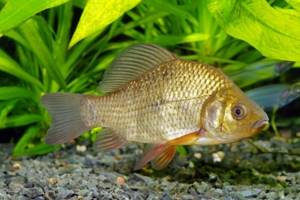
These creatures are part of the class Rayfin, a group of bony fish. For humans, this is a completely harmless creature, but it should be handled carefully, since it has sharp, piercing cartilaginous parts in its dorsal and anal fins. The entire body of this fish is covered with fairly large scales, and its color depends purely on the species. The average lifespan of representatives of the order Cypriniformes is about 8-9 years, but some individuals live 12 years or more. Depending on the variety and age, the fish can weigh about 5 kg and grow up to 60-65 cm.
Rules for feeding crucian carp
To begin with, it is worth understanding that there is no golden recipe here. Often you have to look at someone else and modify it a little at your own discretion. Let's start with the fact that the bait must have a base, most often it is a dry mixture. Filler. Starting from chopped worms and maggots to pearl barley and corn, ending with flavorings, of which there are a huge number on the market.
The feeding season should be divided into stages:
Spring
Spring is divided before and after spawning. It is not advisable to use bait while the water is opaque or in a very small volume. Renew fertilizing no more than once an hour. An obligatory component is the bait used to catch the fish.
Having spawned, the crucian carp enters the active phase, and bait is necessary in order for it to stand still. The filler should include a chopped worm, crushed bloodworms or maggots. Feeding balls should be thrown every 10-15 minutes.
Summer
At this time, the crucian carp switches to plant foods, so various cereals act as fillers. The most popular is millet. It is good because it attracts fish, but this bait is not enough for it. You definitely need to use flavorings. Bait is fed according to the following plan: before fishing, half the mixture is used, then every 20-30 minutes a couple of balls are thrown in.
